Workforce Motivation and its Effect on Employee and Business Performance
VerifiedAdded on 2022/11/30
|9
|2221
|388
AI Summary
This research proposal focuses on the importance of workforce motivation in increasing business and workforce performance. It explores different strategies used to motivate employees and improve business performance, with a case study on Waitrose Ltd. The research aims to understand the concept of workforce motivation, determine strategies used by Waitrose Ltd, and identify the impact of employee motivation on performance.
Contribute Materials
Your contribution can guide someone’s learning journey. Share your
documents today.
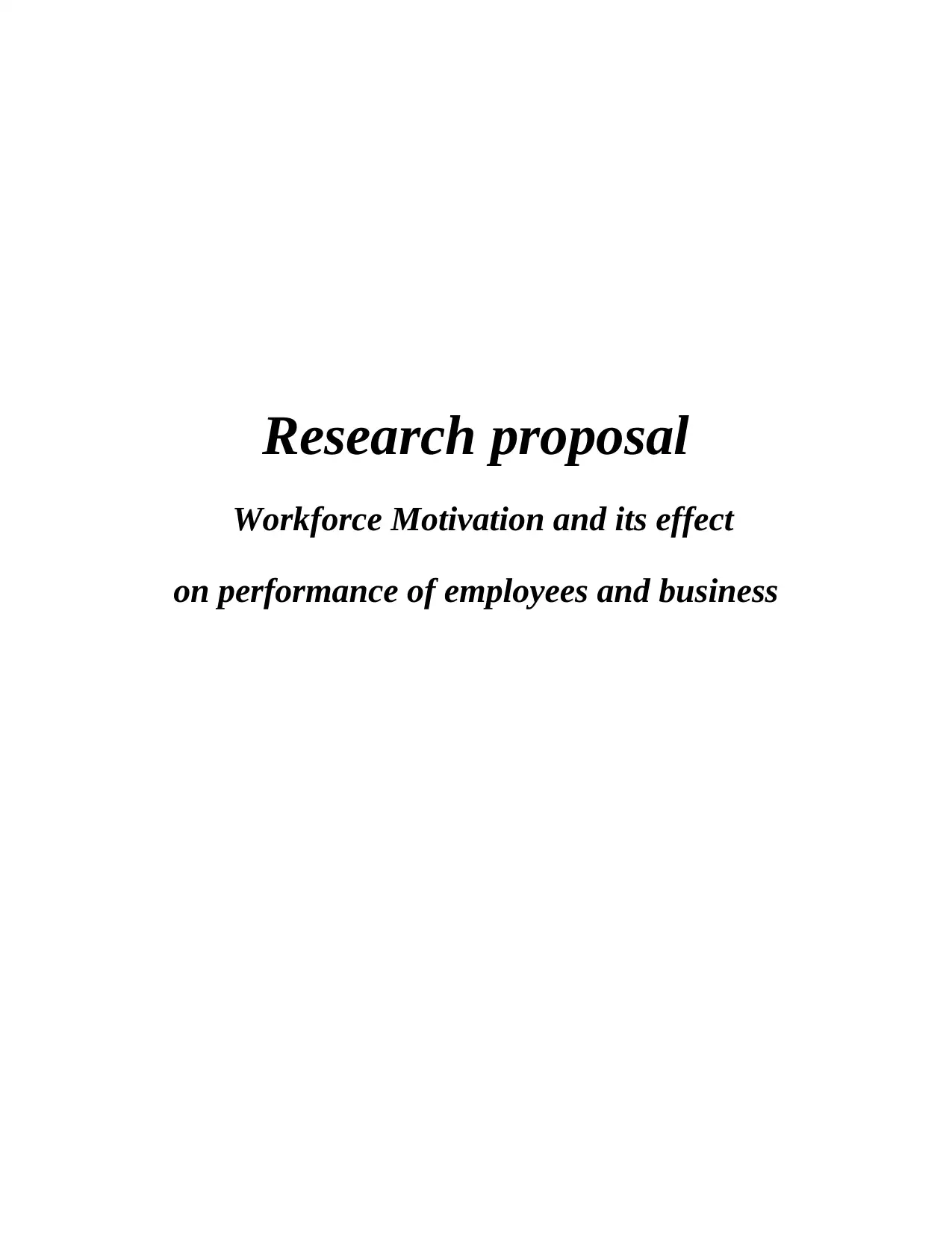
Research proposal
Workforce Motivation and its effect
on performance of employees and business
Workforce Motivation and its effect
on performance of employees and business
Secure Best Marks with AI Grader
Need help grading? Try our AI Grader for instant feedback on your assignments.
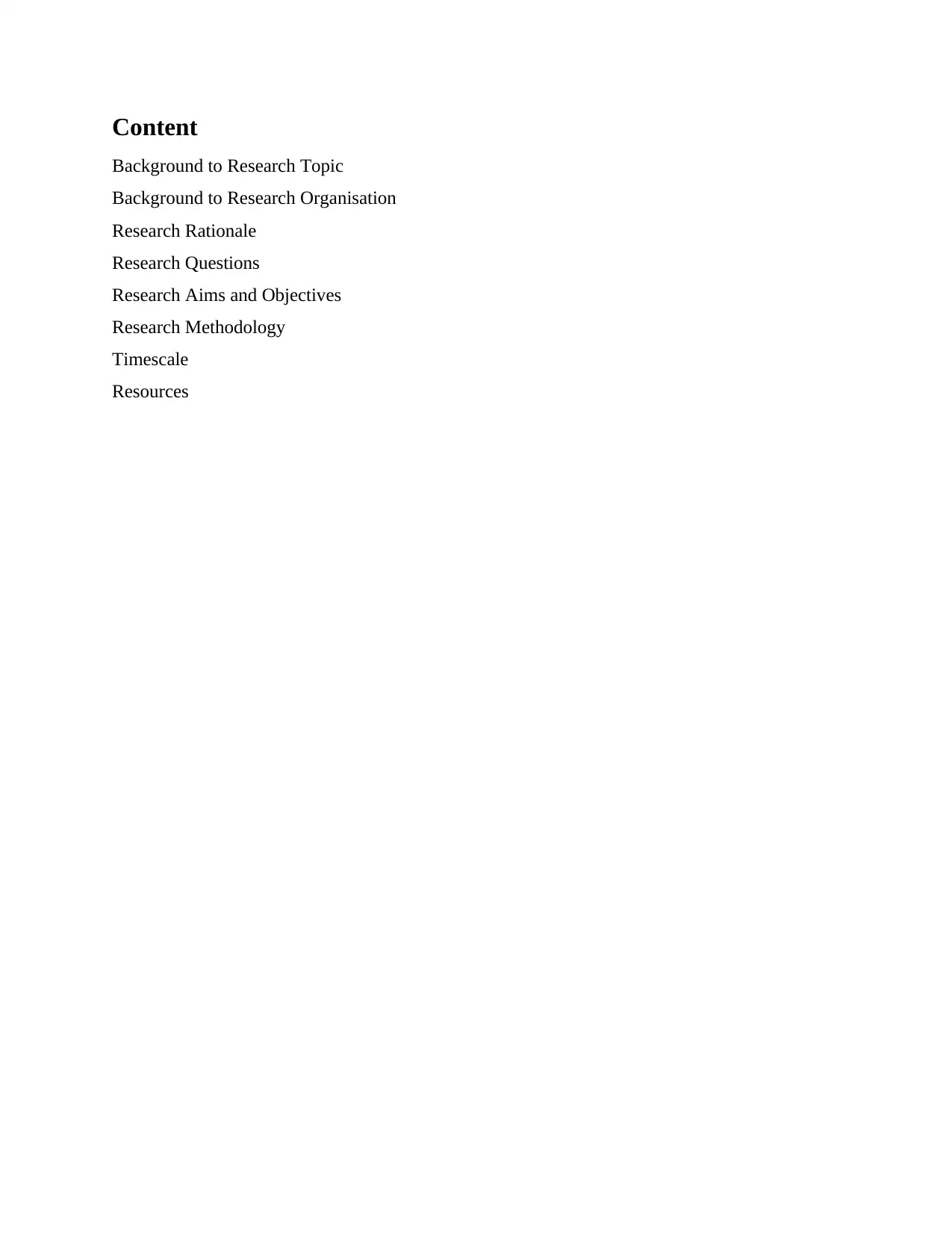
Content
Background to Research Topic
Background to Research Organisation
Research Rationale
Research Questions
Research Aims and Objectives
Research Methodology
Timescale
Resources
Background to Research Topic
Background to Research Organisation
Research Rationale
Research Questions
Research Aims and Objectives
Research Methodology
Timescale
Resources
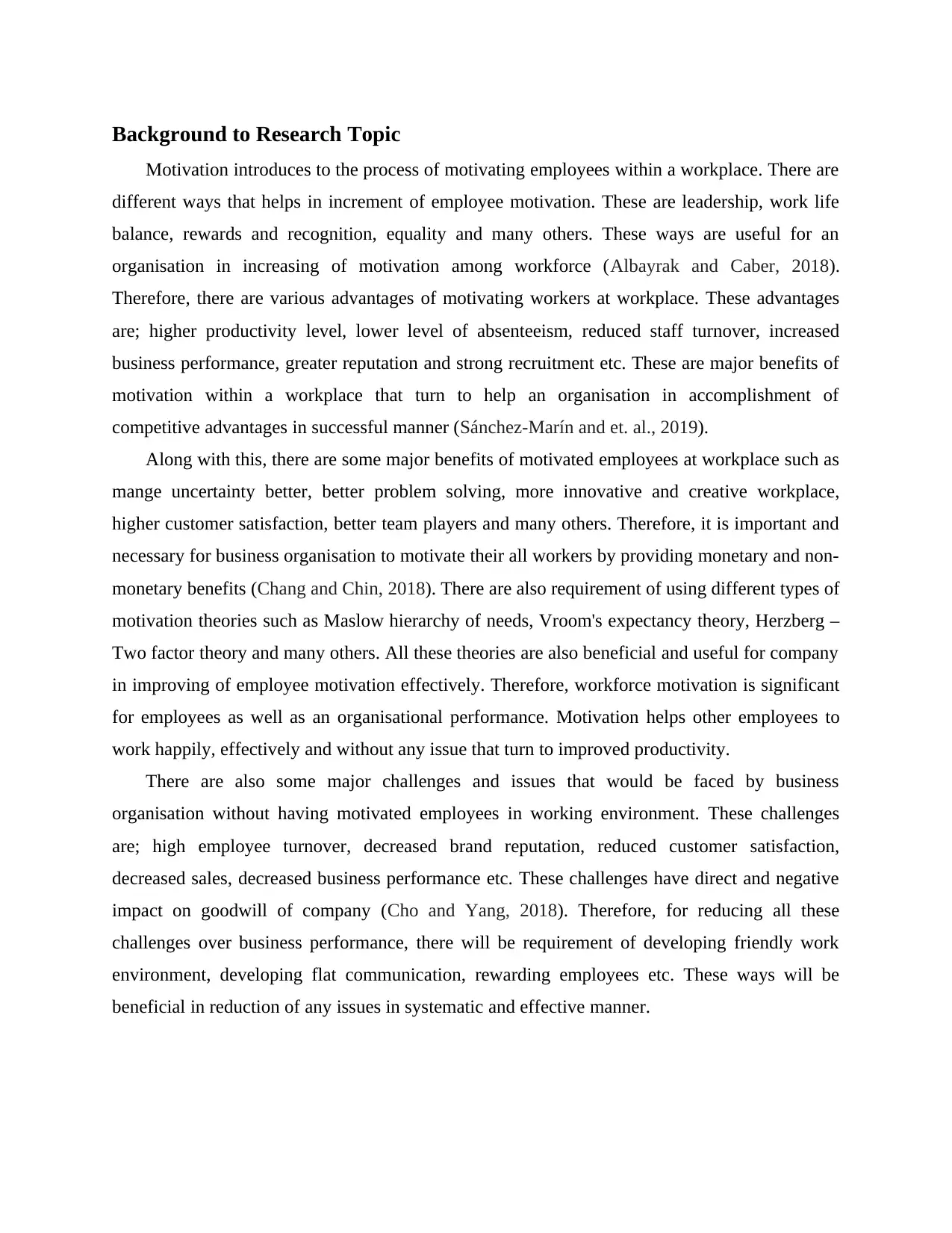
Background to Research Topic
Motivation introduces to the process of motivating employees within a workplace. There are
different ways that helps in increment of employee motivation. These are leadership, work life
balance, rewards and recognition, equality and many others. These ways are useful for an
organisation in increasing of motivation among workforce (Albayrak and Caber, 2018).
Therefore, there are various advantages of motivating workers at workplace. These advantages
are; higher productivity level, lower level of absenteeism, reduced staff turnover, increased
business performance, greater reputation and strong recruitment etc. These are major benefits of
motivation within a workplace that turn to help an organisation in accomplishment of
competitive advantages in successful manner (Sánchez-Marín and et. al., 2019).
Along with this, there are some major benefits of motivated employees at workplace such as
mange uncertainty better, better problem solving, more innovative and creative workplace,
higher customer satisfaction, better team players and many others. Therefore, it is important and
necessary for business organisation to motivate their all workers by providing monetary and non-
monetary benefits (Chang and Chin, 2018). There are also requirement of using different types of
motivation theories such as Maslow hierarchy of needs, Vroom's expectancy theory, Herzberg –
Two factor theory and many others. All these theories are also beneficial and useful for company
in improving of employee motivation effectively. Therefore, workforce motivation is significant
for employees as well as an organisational performance. Motivation helps other employees to
work happily, effectively and without any issue that turn to improved productivity.
There are also some major challenges and issues that would be faced by business
organisation without having motivated employees in working environment. These challenges
are; high employee turnover, decreased brand reputation, reduced customer satisfaction,
decreased sales, decreased business performance etc. These challenges have direct and negative
impact on goodwill of company (Cho and Yang, 2018). Therefore, for reducing all these
challenges over business performance, there will be requirement of developing friendly work
environment, developing flat communication, rewarding employees etc. These ways will be
beneficial in reduction of any issues in systematic and effective manner.
Motivation introduces to the process of motivating employees within a workplace. There are
different ways that helps in increment of employee motivation. These are leadership, work life
balance, rewards and recognition, equality and many others. These ways are useful for an
organisation in increasing of motivation among workforce (Albayrak and Caber, 2018).
Therefore, there are various advantages of motivating workers at workplace. These advantages
are; higher productivity level, lower level of absenteeism, reduced staff turnover, increased
business performance, greater reputation and strong recruitment etc. These are major benefits of
motivation within a workplace that turn to help an organisation in accomplishment of
competitive advantages in successful manner (Sánchez-Marín and et. al., 2019).
Along with this, there are some major benefits of motivated employees at workplace such as
mange uncertainty better, better problem solving, more innovative and creative workplace,
higher customer satisfaction, better team players and many others. Therefore, it is important and
necessary for business organisation to motivate their all workers by providing monetary and non-
monetary benefits (Chang and Chin, 2018). There are also requirement of using different types of
motivation theories such as Maslow hierarchy of needs, Vroom's expectancy theory, Herzberg –
Two factor theory and many others. All these theories are also beneficial and useful for company
in improving of employee motivation effectively. Therefore, workforce motivation is significant
for employees as well as an organisational performance. Motivation helps other employees to
work happily, effectively and without any issue that turn to improved productivity.
There are also some major challenges and issues that would be faced by business
organisation without having motivated employees in working environment. These challenges
are; high employee turnover, decreased brand reputation, reduced customer satisfaction,
decreased sales, decreased business performance etc. These challenges have direct and negative
impact on goodwill of company (Cho and Yang, 2018). Therefore, for reducing all these
challenges over business performance, there will be requirement of developing friendly work
environment, developing flat communication, rewarding employees etc. These ways will be
beneficial in reduction of any issues in systematic and effective manner.
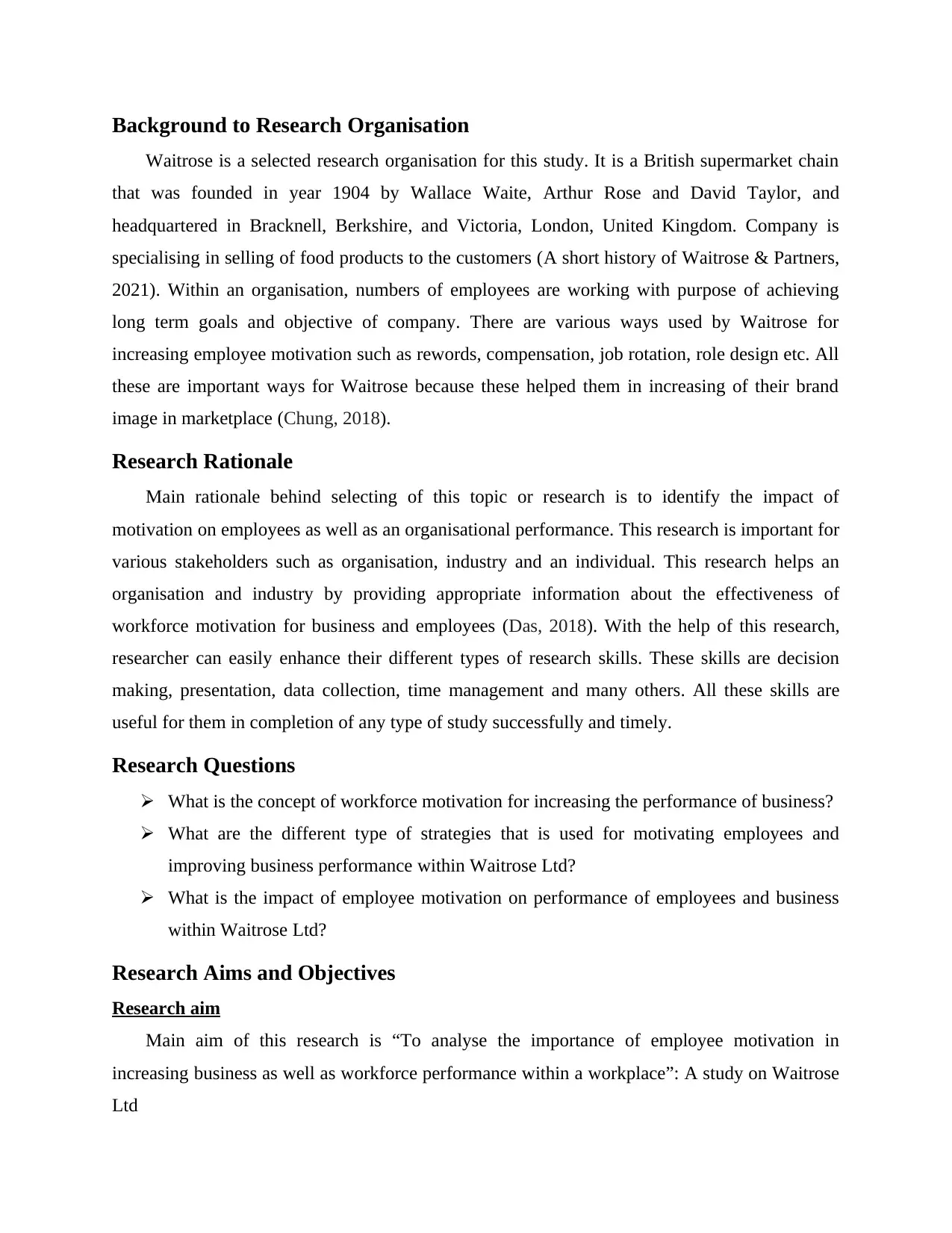
Background to Research Organisation
Waitrose is a selected research organisation for this study. It is a British supermarket chain
that was founded in year 1904 by Wallace Waite, Arthur Rose and David Taylor, and
headquartered in Bracknell, Berkshire, and Victoria, London, United Kingdom. Company is
specialising in selling of food products to the customers (A short history of Waitrose & Partners,
2021). Within an organisation, numbers of employees are working with purpose of achieving
long term goals and objective of company. There are various ways used by Waitrose for
increasing employee motivation such as rewords, compensation, job rotation, role design etc. All
these are important ways for Waitrose because these helped them in increasing of their brand
image in marketplace (Chung, 2018).
Research Rationale
Main rationale behind selecting of this topic or research is to identify the impact of
motivation on employees as well as an organisational performance. This research is important for
various stakeholders such as organisation, industry and an individual. This research helps an
organisation and industry by providing appropriate information about the effectiveness of
workforce motivation for business and employees (Das, 2018). With the help of this research,
researcher can easily enhance their different types of research skills. These skills are decision
making, presentation, data collection, time management and many others. All these skills are
useful for them in completion of any type of study successfully and timely.
Research Questions
What is the concept of workforce motivation for increasing the performance of business?
What are the different type of strategies that is used for motivating employees and
improving business performance within Waitrose Ltd?
What is the impact of employee motivation on performance of employees and business
within Waitrose Ltd?
Research Aims and Objectives
Research aim
Main aim of this research is “To analyse the importance of employee motivation in
increasing business as well as workforce performance within a workplace”: A study on Waitrose
Ltd
Waitrose is a selected research organisation for this study. It is a British supermarket chain
that was founded in year 1904 by Wallace Waite, Arthur Rose and David Taylor, and
headquartered in Bracknell, Berkshire, and Victoria, London, United Kingdom. Company is
specialising in selling of food products to the customers (A short history of Waitrose & Partners,
2021). Within an organisation, numbers of employees are working with purpose of achieving
long term goals and objective of company. There are various ways used by Waitrose for
increasing employee motivation such as rewords, compensation, job rotation, role design etc. All
these are important ways for Waitrose because these helped them in increasing of their brand
image in marketplace (Chung, 2018).
Research Rationale
Main rationale behind selecting of this topic or research is to identify the impact of
motivation on employees as well as an organisational performance. This research is important for
various stakeholders such as organisation, industry and an individual. This research helps an
organisation and industry by providing appropriate information about the effectiveness of
workforce motivation for business and employees (Das, 2018). With the help of this research,
researcher can easily enhance their different types of research skills. These skills are decision
making, presentation, data collection, time management and many others. All these skills are
useful for them in completion of any type of study successfully and timely.
Research Questions
What is the concept of workforce motivation for increasing the performance of business?
What are the different type of strategies that is used for motivating employees and
improving business performance within Waitrose Ltd?
What is the impact of employee motivation on performance of employees and business
within Waitrose Ltd?
Research Aims and Objectives
Research aim
Main aim of this research is “To analyse the importance of employee motivation in
increasing business as well as workforce performance within a workplace”: A study on Waitrose
Ltd
Secure Best Marks with AI Grader
Need help grading? Try our AI Grader for instant feedback on your assignments.
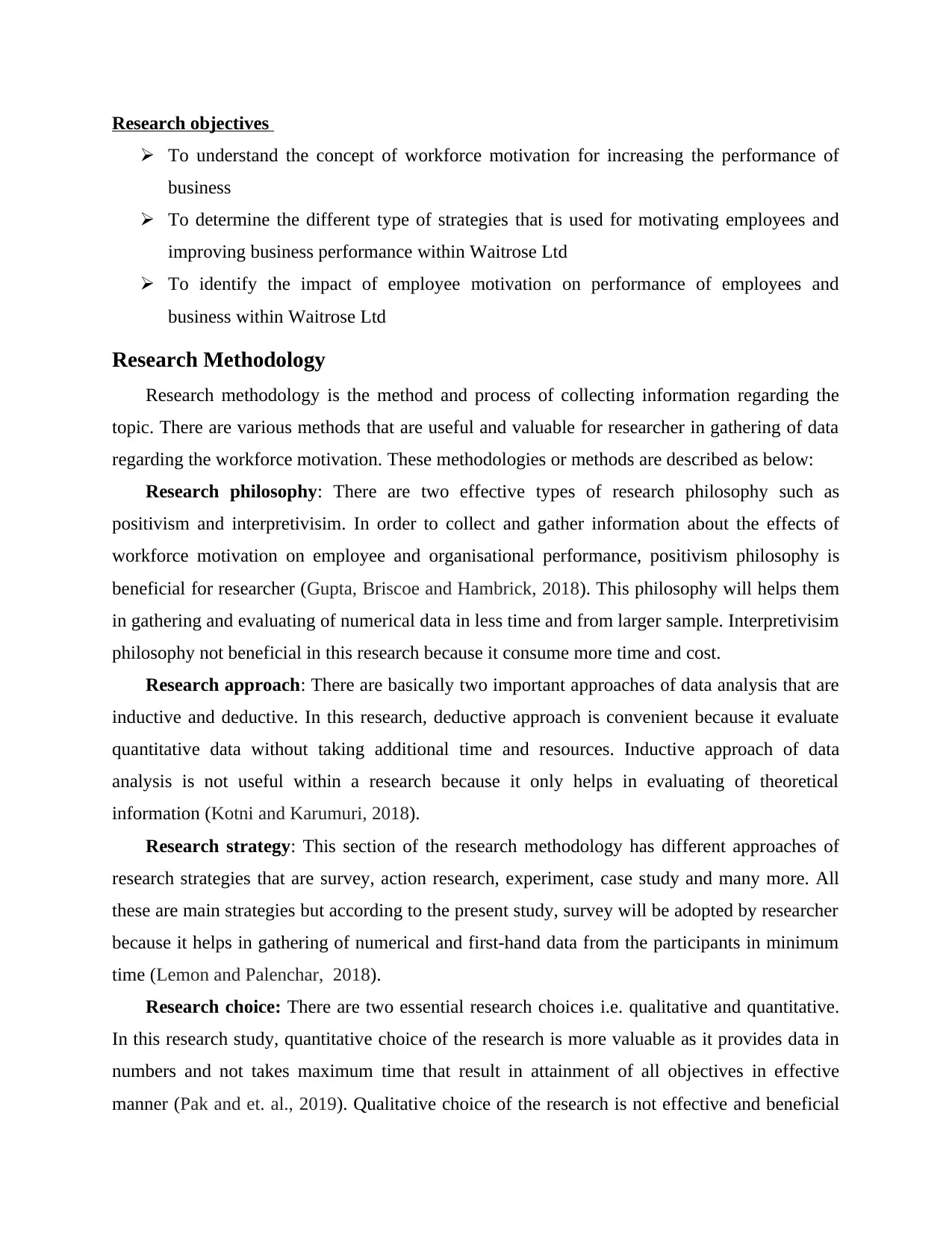
Research objectives
To understand the concept of workforce motivation for increasing the performance of
business
To determine the different type of strategies that is used for motivating employees and
improving business performance within Waitrose Ltd
To identify the impact of employee motivation on performance of employees and
business within Waitrose Ltd
Research Methodology
Research methodology is the method and process of collecting information regarding the
topic. There are various methods that are useful and valuable for researcher in gathering of data
regarding the workforce motivation. These methodologies or methods are described as below:
Research philosophy: There are two effective types of research philosophy such as
positivism and interpretivisim. In order to collect and gather information about the effects of
workforce motivation on employee and organisational performance, positivism philosophy is
beneficial for researcher (Gupta, Briscoe and Hambrick, 2018). This philosophy will helps them
in gathering and evaluating of numerical data in less time and from larger sample. Interpretivisim
philosophy not beneficial in this research because it consume more time and cost.
Research approach: There are basically two important approaches of data analysis that are
inductive and deductive. In this research, deductive approach is convenient because it evaluate
quantitative data without taking additional time and resources. Inductive approach of data
analysis is not useful within a research because it only helps in evaluating of theoretical
information (Kotni and Karumuri, 2018).
Research strategy: This section of the research methodology has different approaches of
research strategies that are survey, action research, experiment, case study and many more. All
these are main strategies but according to the present study, survey will be adopted by researcher
because it helps in gathering of numerical and first-hand data from the participants in minimum
time (Lemon and Palenchar, 2018).
Research choice: There are two essential research choices i.e. qualitative and quantitative.
In this research study, quantitative choice of the research is more valuable as it provides data in
numbers and not takes maximum time that result in attainment of all objectives in effective
manner (Pak and et. al., 2019). Qualitative choice of the research is not effective and beneficial
To understand the concept of workforce motivation for increasing the performance of
business
To determine the different type of strategies that is used for motivating employees and
improving business performance within Waitrose Ltd
To identify the impact of employee motivation on performance of employees and
business within Waitrose Ltd
Research Methodology
Research methodology is the method and process of collecting information regarding the
topic. There are various methods that are useful and valuable for researcher in gathering of data
regarding the workforce motivation. These methodologies or methods are described as below:
Research philosophy: There are two effective types of research philosophy such as
positivism and interpretivisim. In order to collect and gather information about the effects of
workforce motivation on employee and organisational performance, positivism philosophy is
beneficial for researcher (Gupta, Briscoe and Hambrick, 2018). This philosophy will helps them
in gathering and evaluating of numerical data in less time and from larger sample. Interpretivisim
philosophy not beneficial in this research because it consume more time and cost.
Research approach: There are basically two important approaches of data analysis that are
inductive and deductive. In this research, deductive approach is convenient because it evaluate
quantitative data without taking additional time and resources. Inductive approach of data
analysis is not useful within a research because it only helps in evaluating of theoretical
information (Kotni and Karumuri, 2018).
Research strategy: This section of the research methodology has different approaches of
research strategies that are survey, action research, experiment, case study and many more. All
these are main strategies but according to the present study, survey will be adopted by researcher
because it helps in gathering of numerical and first-hand data from the participants in minimum
time (Lemon and Palenchar, 2018).
Research choice: There are two essential research choices i.e. qualitative and quantitative.
In this research study, quantitative choice of the research is more valuable as it provides data in
numbers and not takes maximum time that result in attainment of all objectives in effective
manner (Pak and et. al., 2019). Qualitative choice of the research is not effective and beneficial
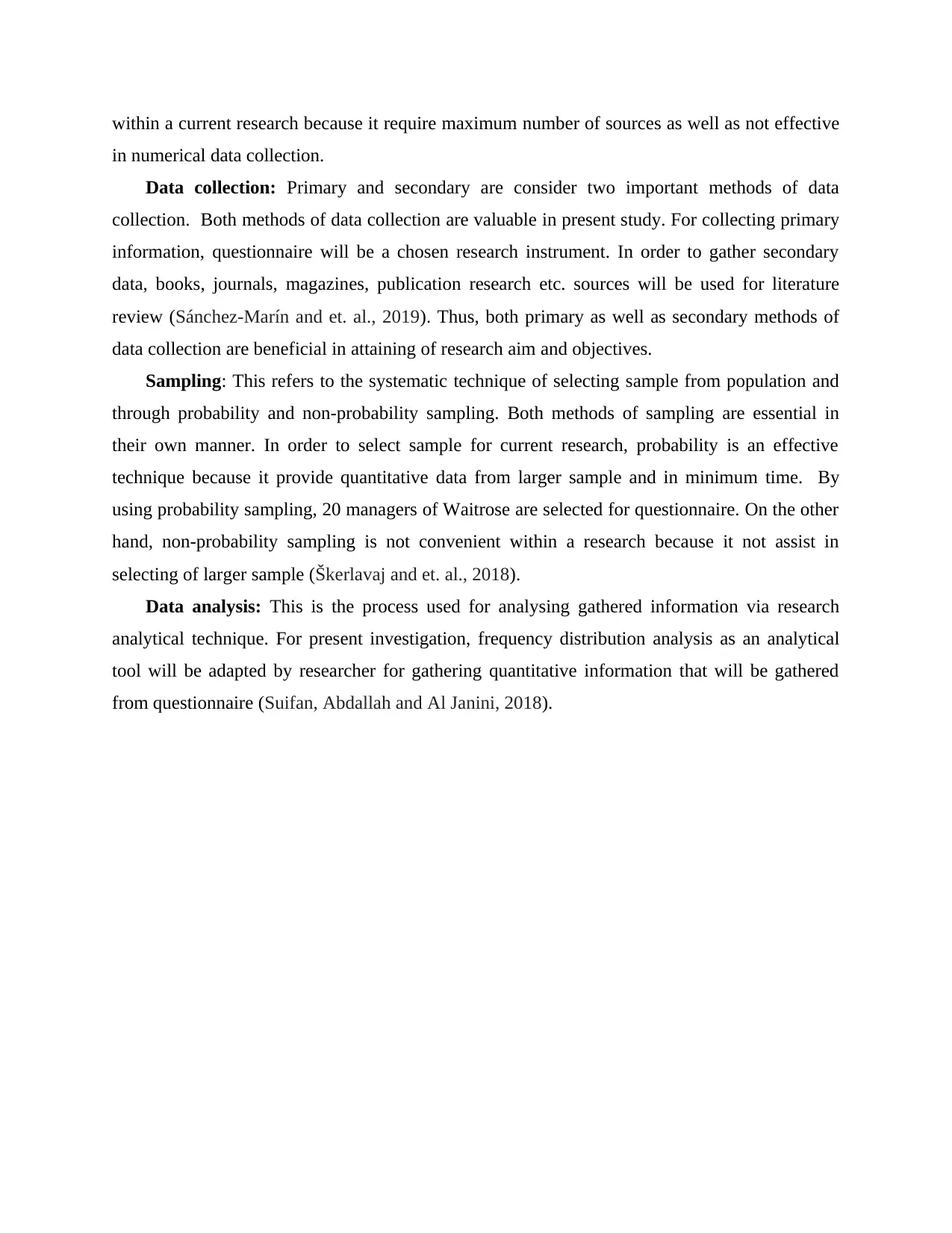
within a current research because it require maximum number of sources as well as not effective
in numerical data collection.
Data collection: Primary and secondary are consider two important methods of data
collection. Both methods of data collection are valuable in present study. For collecting primary
information, questionnaire will be a chosen research instrument. In order to gather secondary
data, books, journals, magazines, publication research etc. sources will be used for literature
review (Sánchez-Marín and et. al., 2019). Thus, both primary as well as secondary methods of
data collection are beneficial in attaining of research aim and objectives.
Sampling: This refers to the systematic technique of selecting sample from population and
through probability and non-probability sampling. Both methods of sampling are essential in
their own manner. In order to select sample for current research, probability is an effective
technique because it provide quantitative data from larger sample and in minimum time. By
using probability sampling, 20 managers of Waitrose are selected for questionnaire. On the other
hand, non-probability sampling is not convenient within a research because it not assist in
selecting of larger sample (Škerlavaj and et. al., 2018).
Data analysis: This is the process used for analysing gathered information via research
analytical technique. For present investigation, frequency distribution analysis as an analytical
tool will be adapted by researcher for gathering quantitative information that will be gathered
from questionnaire (Suifan, Abdallah and Al Janini, 2018).
in numerical data collection.
Data collection: Primary and secondary are consider two important methods of data
collection. Both methods of data collection are valuable in present study. For collecting primary
information, questionnaire will be a chosen research instrument. In order to gather secondary
data, books, journals, magazines, publication research etc. sources will be used for literature
review (Sánchez-Marín and et. al., 2019). Thus, both primary as well as secondary methods of
data collection are beneficial in attaining of research aim and objectives.
Sampling: This refers to the systematic technique of selecting sample from population and
through probability and non-probability sampling. Both methods of sampling are essential in
their own manner. In order to select sample for current research, probability is an effective
technique because it provide quantitative data from larger sample and in minimum time. By
using probability sampling, 20 managers of Waitrose are selected for questionnaire. On the other
hand, non-probability sampling is not convenient within a research because it not assist in
selecting of larger sample (Škerlavaj and et. al., 2018).
Data analysis: This is the process used for analysing gathered information via research
analytical technique. For present investigation, frequency distribution analysis as an analytical
tool will be adapted by researcher for gathering quantitative information that will be gathered
from questionnaire (Suifan, Abdallah and Al Janini, 2018).
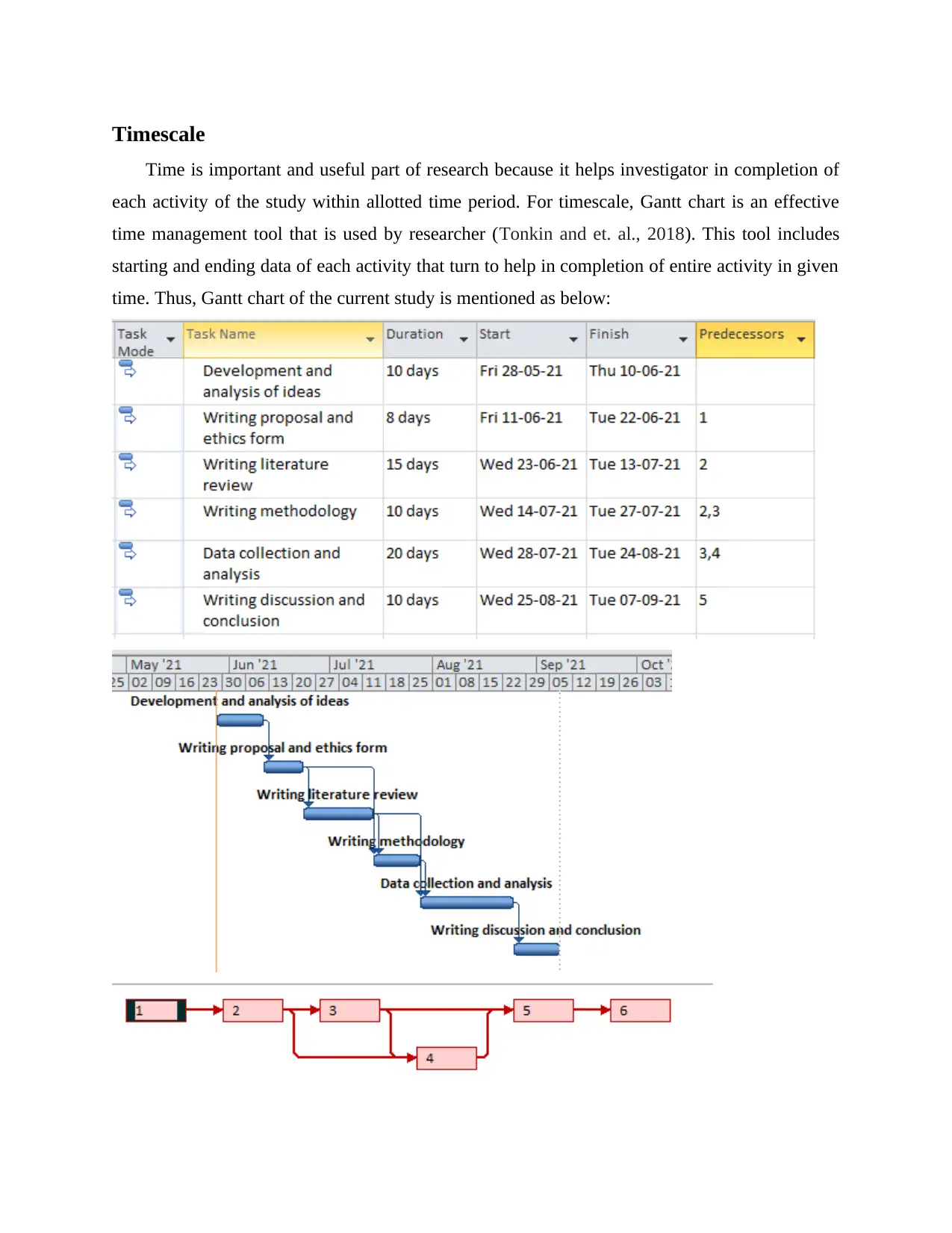
Timescale
Time is important and useful part of research because it helps investigator in completion of
each activity of the study within allotted time period. For timescale, Gantt chart is an effective
time management tool that is used by researcher (Tonkin and et. al., 2018). This tool includes
starting and ending data of each activity that turn to help in completion of entire activity in given
time. Thus, Gantt chart of the current study is mentioned as below:
Time is important and useful part of research because it helps investigator in completion of
each activity of the study within allotted time period. For timescale, Gantt chart is an effective
time management tool that is used by researcher (Tonkin and et. al., 2018). This tool includes
starting and ending data of each activity that turn to help in completion of entire activity in given
time. Thus, Gantt chart of the current study is mentioned as below:
Paraphrase This Document
Need a fresh take? Get an instant paraphrase of this document with our AI Paraphraser
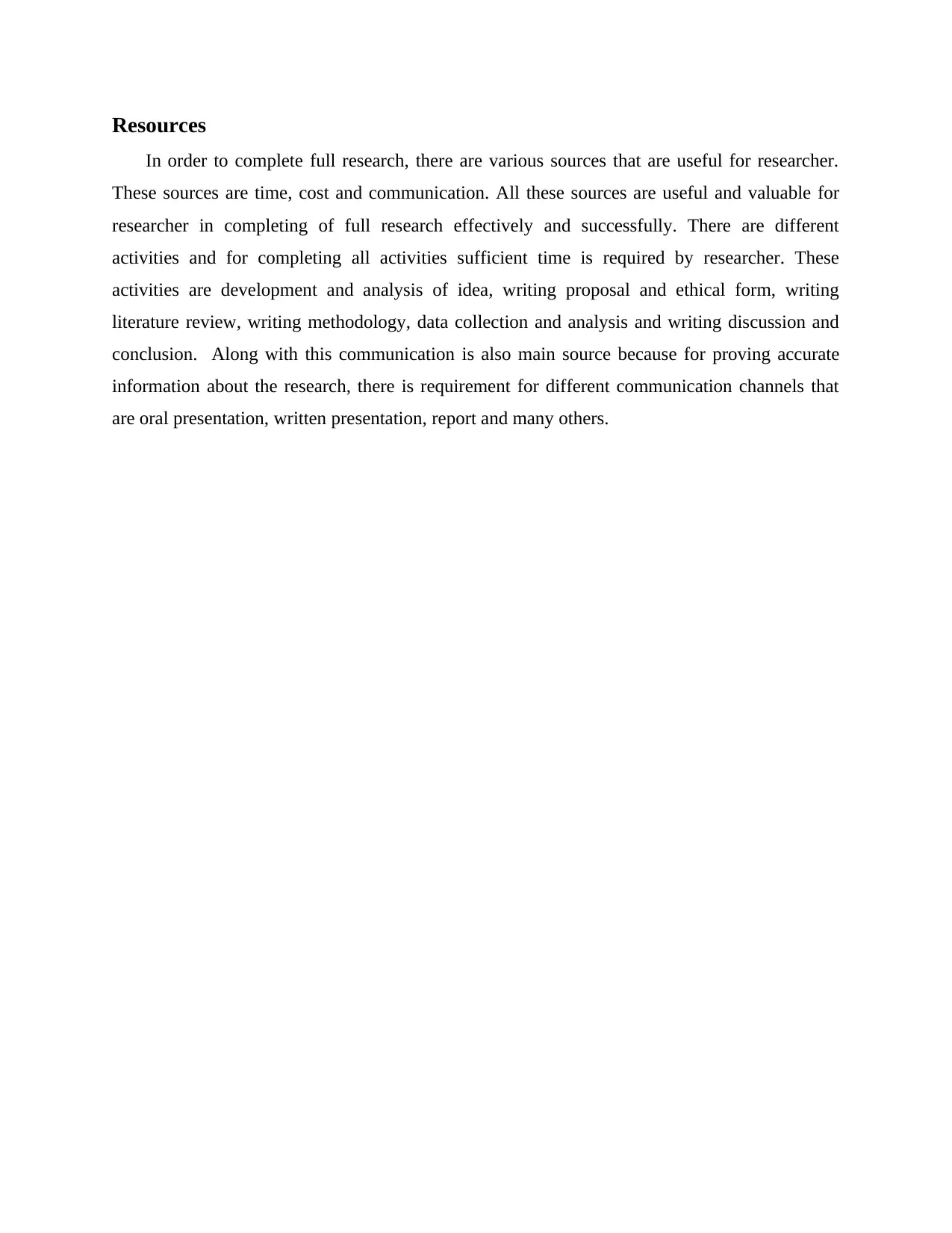
Resources
In order to complete full research, there are various sources that are useful for researcher.
These sources are time, cost and communication. All these sources are useful and valuable for
researcher in completing of full research effectively and successfully. There are different
activities and for completing all activities sufficient time is required by researcher. These
activities are development and analysis of idea, writing proposal and ethical form, writing
literature review, writing methodology, data collection and analysis and writing discussion and
conclusion. Along with this communication is also main source because for proving accurate
information about the research, there is requirement for different communication channels that
are oral presentation, written presentation, report and many others.
In order to complete full research, there are various sources that are useful for researcher.
These sources are time, cost and communication. All these sources are useful and valuable for
researcher in completing of full research effectively and successfully. There are different
activities and for completing all activities sufficient time is required by researcher. These
activities are development and analysis of idea, writing proposal and ethical form, writing
literature review, writing methodology, data collection and analysis and writing discussion and
conclusion. Along with this communication is also main source because for proving accurate
information about the research, there is requirement for different communication channels that
are oral presentation, written presentation, report and many others.
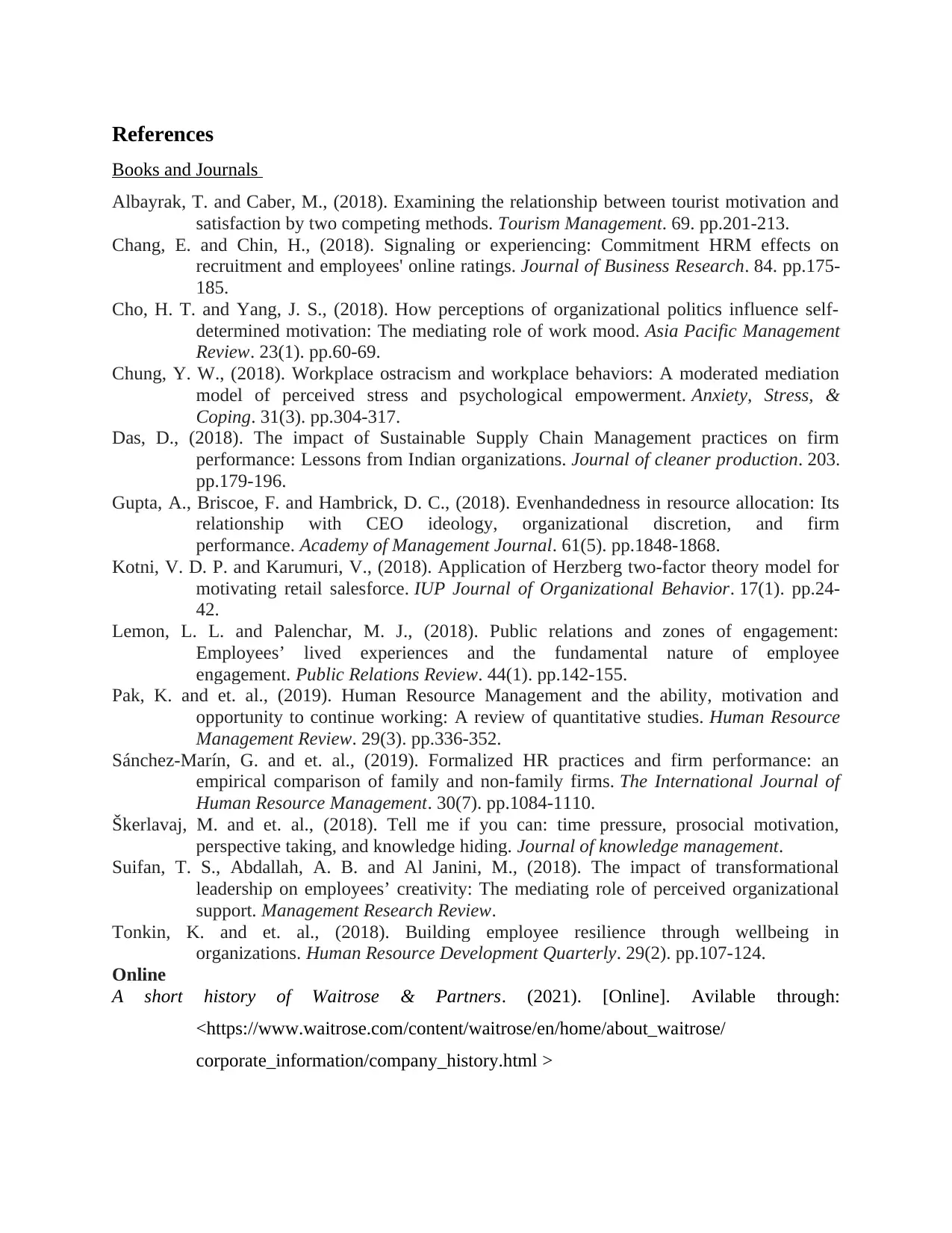
References
Books and Journals
Albayrak, T. and Caber, M., (2018). Examining the relationship between tourist motivation and
satisfaction by two competing methods. Tourism Management. 69. pp.201-213.
Chang, E. and Chin, H., (2018). Signaling or experiencing: Commitment HRM effects on
recruitment and employees' online ratings. Journal of Business Research. 84. pp.175-
185.
Cho, H. T. and Yang, J. S., (2018). How perceptions of organizational politics influence self-
determined motivation: The mediating role of work mood. Asia Pacific Management
Review. 23(1). pp.60-69.
Chung, Y. W., (2018). Workplace ostracism and workplace behaviors: A moderated mediation
model of perceived stress and psychological empowerment. Anxiety, Stress, &
Coping. 31(3). pp.304-317.
Das, D., (2018). The impact of Sustainable Supply Chain Management practices on firm
performance: Lessons from Indian organizations. Journal of cleaner production. 203.
pp.179-196.
Gupta, A., Briscoe, F. and Hambrick, D. C., (2018). Evenhandedness in resource allocation: Its
relationship with CEO ideology, organizational discretion, and firm
performance. Academy of Management Journal. 61(5). pp.1848-1868.
Kotni, V. D. P. and Karumuri, V., (2018). Application of Herzberg two-factor theory model for
motivating retail salesforce. IUP Journal of Organizational Behavior. 17(1). pp.24-
42.
Lemon, L. L. and Palenchar, M. J., (2018). Public relations and zones of engagement:
Employees’ lived experiences and the fundamental nature of employee
engagement. Public Relations Review. 44(1). pp.142-155.
Pak, K. and et. al., (2019). Human Resource Management and the ability, motivation and
opportunity to continue working: A review of quantitative studies. Human Resource
Management Review. 29(3). pp.336-352.
Sánchez-Marín, G. and et. al., (2019). Formalized HR practices and firm performance: an
empirical comparison of family and non-family firms. The International Journal of
Human Resource Management. 30(7). pp.1084-1110.
Škerlavaj, M. and et. al., (2018). Tell me if you can: time pressure, prosocial motivation,
perspective taking, and knowledge hiding. Journal of knowledge management.
Suifan, T. S., Abdallah, A. B. and Al Janini, M., (2018). The impact of transformational
leadership on employees’ creativity: The mediating role of perceived organizational
support. Management Research Review.
Tonkin, K. and et. al., (2018). Building employee resilience through wellbeing in
organizations. Human Resource Development Quarterly. 29(2). pp.107-124.
Online
A short history of Waitrose & Partners. (2021). [Online]. Avilable through:
<https://www.waitrose.com/content/waitrose/en/home/about_waitrose/
corporate_information/company_history.html >
Books and Journals
Albayrak, T. and Caber, M., (2018). Examining the relationship between tourist motivation and
satisfaction by two competing methods. Tourism Management. 69. pp.201-213.
Chang, E. and Chin, H., (2018). Signaling or experiencing: Commitment HRM effects on
recruitment and employees' online ratings. Journal of Business Research. 84. pp.175-
185.
Cho, H. T. and Yang, J. S., (2018). How perceptions of organizational politics influence self-
determined motivation: The mediating role of work mood. Asia Pacific Management
Review. 23(1). pp.60-69.
Chung, Y. W., (2018). Workplace ostracism and workplace behaviors: A moderated mediation
model of perceived stress and psychological empowerment. Anxiety, Stress, &
Coping. 31(3). pp.304-317.
Das, D., (2018). The impact of Sustainable Supply Chain Management practices on firm
performance: Lessons from Indian organizations. Journal of cleaner production. 203.
pp.179-196.
Gupta, A., Briscoe, F. and Hambrick, D. C., (2018). Evenhandedness in resource allocation: Its
relationship with CEO ideology, organizational discretion, and firm
performance. Academy of Management Journal. 61(5). pp.1848-1868.
Kotni, V. D. P. and Karumuri, V., (2018). Application of Herzberg two-factor theory model for
motivating retail salesforce. IUP Journal of Organizational Behavior. 17(1). pp.24-
42.
Lemon, L. L. and Palenchar, M. J., (2018). Public relations and zones of engagement:
Employees’ lived experiences and the fundamental nature of employee
engagement. Public Relations Review. 44(1). pp.142-155.
Pak, K. and et. al., (2019). Human Resource Management and the ability, motivation and
opportunity to continue working: A review of quantitative studies. Human Resource
Management Review. 29(3). pp.336-352.
Sánchez-Marín, G. and et. al., (2019). Formalized HR practices and firm performance: an
empirical comparison of family and non-family firms. The International Journal of
Human Resource Management. 30(7). pp.1084-1110.
Škerlavaj, M. and et. al., (2018). Tell me if you can: time pressure, prosocial motivation,
perspective taking, and knowledge hiding. Journal of knowledge management.
Suifan, T. S., Abdallah, A. B. and Al Janini, M., (2018). The impact of transformational
leadership on employees’ creativity: The mediating role of perceived organizational
support. Management Research Review.
Tonkin, K. and et. al., (2018). Building employee resilience through wellbeing in
organizations. Human Resource Development Quarterly. 29(2). pp.107-124.
Online
A short history of Waitrose & Partners. (2021). [Online]. Avilable through:
<https://www.waitrose.com/content/waitrose/en/home/about_waitrose/
corporate_information/company_history.html >
1 out of 9
Related Documents
Your All-in-One AI-Powered Toolkit for Academic Success.
+13062052269
info@desklib.com
Available 24*7 on WhatsApp / Email
![[object Object]](/_next/static/media/star-bottom.7253800d.svg)
Unlock your academic potential
© 2024 | Zucol Services PVT LTD | All rights reserved.





